
Heller 1/400 DKM Gneiesenau
|
KIT # |
1037 |
|
PRICE: |
$11.00 (Obviously not retail) |
|
DECALS: |
Crests and flags |
|
REVIEWER: |
Len Roberto |
|
NOTES: |
Gold Models P.E. set |

|
HISTORY |
For those who like their bit of history (see reference section for the excellent site on the Scharnhorst class ships whose owner graciously allowed me to use this data)
Operational History :
Construction
8 December 1936 Gneisenau was launched. Christened by the widow of Kapitän zur See (Captain) Julius Maerker, commander of the armoured cruiser Gneisenau, lost with his ship at the Battle of the Falkland Islands on 8 December 1914.
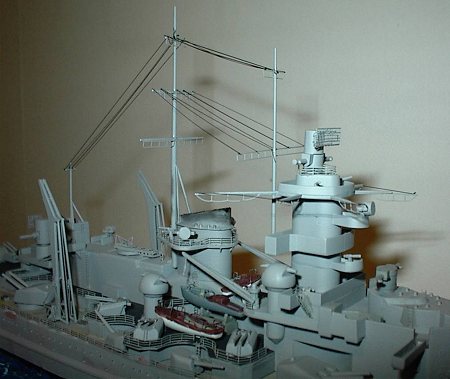 Commissioning and Trials
Commissioning and Trials
21 May 1938 Gneisenau was commissioned and placed under the command of Kapitän zur See (Captain) Erich Förste .
Afterwards, training and trials.
August - November 1938 Battle training in the North Atlantic.
Battle History
October 1939 Raid to intercept Britain - Scandinavia trade together with the light cruiser Köln and the destroyers Wilhelm Heidkamp, Friedrich Ihn, Diether von Roeder, Karl Galster, Max Schulz, Paul Jakobi, Bernd von Arnim, Erich Steinbrink and Freidrich Eckoldt. No results.
21 November 1939 Together with the Scharnhorst, the Gneisenau was sent south of Iceland to attack the Northern Patrol.
23 November 1939 The Gneisenau and the Scharnhorst sinks the British auxiliary cruiser Rawalpindi.
26 November 1939 The Gneisenau suffered severe sea damage during a heavy storm in the Shetland - Bergen Narrows.
27 November 1939 The Gneisenau and the Scharnhorst returns to Kiel.
4 December 1939 Repairs completed. The Gneisenau transfers to Wilhelmshaven.
18 - 20 February 1940
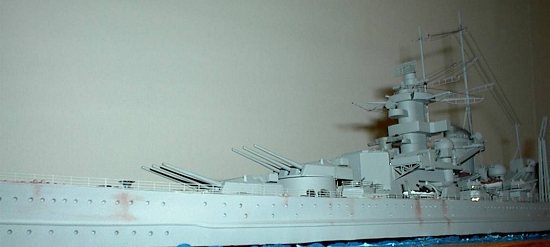 Operation "Nordmark" The Gneisenau, the Scharnhorst, the
heavy cruiser Admiral Hipper and the destroyers Wolfgang Zenker, Wilhelm
Heidkamp and Karl Galster was sent to intercept British convoys between Bergen
and England, but no ships was sighted.
Operation "Nordmark" The Gneisenau, the Scharnhorst, the
heavy cruiser Admiral Hipper and the destroyers Wolfgang Zenker, Wilhelm
Heidkamp and Karl Galster was sent to intercept British convoys between Bergen
and England, but no ships was sighted.
7 - 12 April 1940
Operation "Weserübung" The Gneisenau was flagship of the fleet commander Vice-Admiral Lütjens. The Gneisenau and the Scharnhorst cover the invasion of Narvik. Battle with British battlecruiser Renown and cruiser Birmingham west of the Lofoten in bad weather. The Gneisenau was hit once.
4 - 10 June 1940
Operation "Juno" The Gneisenau was flagship in the Polar Sea operations together with the Scharnhorst, Admiral Hipper and the destroyers Karl Galster, Hans Lody, Erich Steinbrink and Hermann Schoemann.
8 June 1940 Battle with British aircraft carrier Glorious and the destroyers Ardent and Acasta. All British ships are sunk.
10 June 1940 Returned to Trondheim.
10-12 June 1940 Sailed into the Polar Sea with Admiral Hipper. Operations canceled, ships return to Trondheim again.
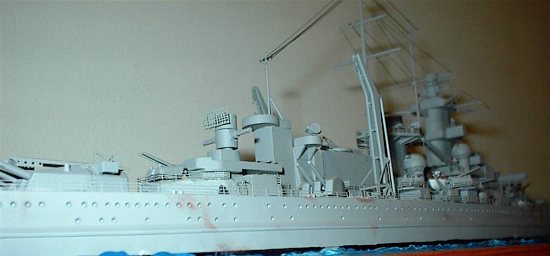 20 June 1940 Leaves Trondheim with Admiral Hipper again
for operations between Iceland, the Faroers and Orkney. 40 nautical miles
north-west of the island of Halten, Gneisenau is hit by a torpedo of the British
submarine Clyde. Emergency repairs at Trondheim.
20 June 1940 Leaves Trondheim with Admiral Hipper again
for operations between Iceland, the Faroers and Orkney. 40 nautical miles
north-west of the island of Halten, Gneisenau is hit by a torpedo of the British
submarine Clyde. Emergency repairs at Trondheim.
25 July 1940 Escorted by the light cruiser Nürnberg, the Gneisenau leaves Trondheim to return to Kiel.
28 July 1940 The Gneisenau arrived at Kiel.
July - December 1940 The Gneisenau was in dock.
28 December 1940 First unsuccessful attempt to break out in the North Atlantic together with the Scharnhorst. Operation is aborted after the Gneisenau is damaged by heavy seas.
22 January 1941
Operation "Berlin" Second successful attempt to break out into the North Atlantic by the Gneisenau and the Scharnhorst.
3 February 1941 The Gneisenau and the Scharnhorst break through the Denmark Strait.
4 February 1941 The Gneisenau and the Scharnhorst reached southern Greenland.
8 February 1941 Convoy HX-108 was sighted but the attack was stopped after the British battleship Ramiles is detected covering this convoy. Scharnhorst unsuccessfully tried to pull the British battleship away of the convoy to enable the Gneisenau to attack the unprotected merchant ships.
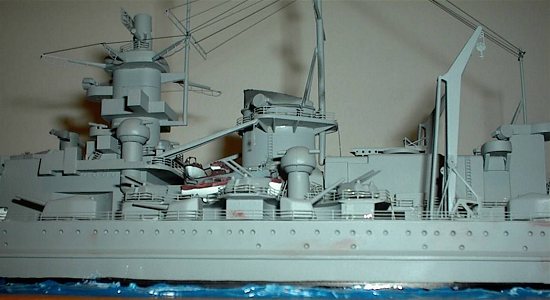 22 February 1941 The Gneisenau and the Scharnhorst sinks
four merchant ships east of Newfoundland.
22 February 1941 The Gneisenau and the Scharnhorst sinks
four merchant ships east of Newfoundland.
7 - 9 March 1941 Attack on convoy SL-67 is broken off as the British battleship Malaya is sighted. Two U-boats are ordered to attack the convoy and sink 5 merchant ships.
15 - 16 March 1941 The Gneisenau and the Scharnhorst sink 16 merchant ships east of Newfoundland. Gneisenau is sighted by the British battleship Rodney which requests identification of the German ship. The Gneisenau replies "H.M.S. Emerald" and escapes.
22 March 1941 The Gneisenau and the Scharnhorst enter Brest. They sunk a total of 22 ships with total of 115.600 tons during their North Atlantic Operations. The Gneisenau sunk 14 ships with total of 66.300 tons.
April 1941 The Gneisenau was hit by an aircraft torpedo and put into dock.
11 - 13 February 1942
Operation "Cerberus" Break through the English Channel: The Gneisenau, the Scharnhorst and the heavy cruiser Prinz Eugen, escorted by 6 destroyers (Paul Jakobi, Richard Beitzen, Friedrich Ihn, Hermann Schoemann, Z-25, Z-29). Nine torpedo-boats of the 2nd and 3rd Flotillas (T-2, T-4, T-5, T-11, T-12, T-13, T-15, T-16 and T-17) would be joined later by Kondor, Falke, Seeadler, Iltis and Jaguar of the 5th Flotilla plus ten E-boats of the 2nd, 4th and 6th Flotilla, returned to Germany. The Gneisenau was hit by a mine on the Brunsbüttel Roads on its way to Kiel.
26 - 27 February 1942 The Gneisenau was hit by a large bomb during an air attack. The complete bow section burns out and takes the ship out of action.
4 April 1942 The Gneisenau was sent to Gotenhafen to be decommissioned and reconstructed.
 1 July 1942 The Gneisenau was withdrawn from service.
The 28 cm (11") triple turrets should be replaced with 38 cm (15") twin turrets.
1 July 1942 The Gneisenau was withdrawn from service.
The 28 cm (11") triple turrets should be replaced with 38 cm (15") twin turrets.
1944 After the sinking of the Scharnhorst, conversion work was stopped on the Gneisenau.
March 1945 The Gneisenau was sunk as a blockade ship in Gotenhafen.
Final Fate
1947 - 1951 The Gneisenau was broken up and scrapped.
|
THE KIT |
I picked up this Heller 1/400 German Warship kit for only $11.00 through a super ModelExpo sale. A Gold Medal Models brass detail set for $28.00 completed this cheap ship project.
The Heller 1/400 series of kits are great starting points- shapes are usually correct but details are rather soft. This is why a brass photo-etched set is almost essential on these kits. These are not Tamigawa kits; pretty much every single part needs some measure of sanding to clean them up and most assemblies require some putty. Yet they have a certain charm. They include real anchor chain and are a good value for their cost- especially when you can get them on sale!
|
CONSTRUCTION |
My usual sub-assemblies method was followed, adding and replacing brass parts where applicable.
MAIN GUN TURRETS: brass ladders fitted to both sides of each turret and brass sight hoods added to each turret extension.
STACK AND AFT MAST: brass footropes added to yards, brass grill added to Stack, railing added around platform, and ladders added to stack sides.
AIRCRAFT HANGAR AND CATAPULT: Had to g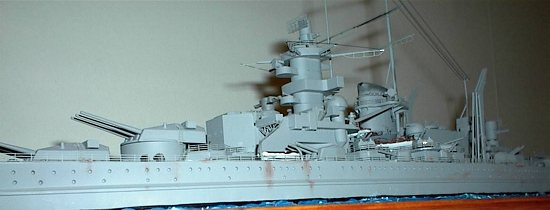 et creative
here—I replaced the kit plastic cat and shuttle by cutting half of the brass
catapult supplied in the GMM set. Also added vertical ladders for access to
rear gun tub.
et creative
here—I replaced the kit plastic cat and shuttle by cutting half of the brass
catapult supplied in the GMM set. Also added vertical ladders for access to
rear gun tub.
BRIDGE AND SUPERSTRUCTURE: footropes added to all yards, plastic ladders were discarded and replaced with brass inclined and vertical ladders, various watertight doors added,
SECOND DECK LEVEL: added brass doors and life rings- the rest was assembled as per instructions. The brass railing all around this deck level was left off until the dark grey (non-skid?) was painted on the horizontal surfaces.
HULL: Was assembled as per instructions then using my Dremel cutter, the lower hull was cut off right in the middle of the boot topping.
|
CAMOUFLAGE & MARKINGS |
I wanted a simple paint scheme for the ship mostly because it has been below freezing for quite a while and my airbrush does not like cold weather. (The wife makes me spray as far from the house as possible)
I went for the basic scheme most German ships wore during trials and workup. It is basically a light grey with wood decking. I used Tamiya Deck Tan for the wood deck after which I heavily scuff with various pastel chalks to break up the monotone tan. This, at least to my eye, gives a good account of various strips of multi-colored wood decking.
For the grey, I had various mixtures of grey ready to match as closely as I could but imagine my joy when I went to prime the model with some new can of primer I picked up at Loew’s…it was almost a perfect match! So being the lazy modeler that I am, I went with it. Various weathering sessions later on would blend and distort this coat to make it acceptable for me.
For the dark grey armored decks, I used Tamiya German Grey, which is a dark, gunship grayish color that I thought matched well.
|
MORE CONSTRUCTION |
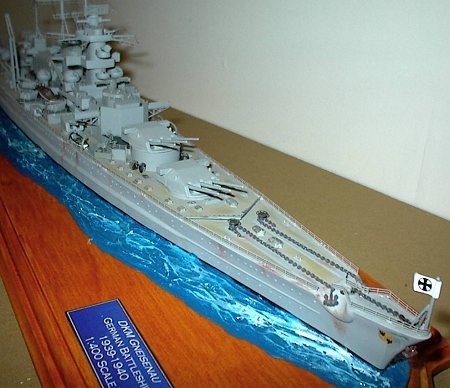 After the relatively easy painting was done, I added the
various sub-assemblies to the hull. Had a bit of trouble getting the second
deck level on the hull. Heller provides massive locating notches that the
bulkheads fit snugly over. Of course my fastidiousness of assembling the deck
level made it a little too snug and I had to stop gluing and cut off these
locating nubs in order for the deck to sit flush. As it was, I still had some
gaps I had to work hard at to close up…don’t look to closely at the starboard
side!
After the relatively easy painting was done, I added the
various sub-assemblies to the hull. Had a bit of trouble getting the second
deck level on the hull. Heller provides massive locating notches that the
bulkheads fit snugly over. Of course my fastidiousness of assembling the deck
level made it a little too snug and I had to stop gluing and cut off these
locating nubs in order for the deck to sit flush. As it was, I still had some
gaps I had to work hard at to close up…don’t look to closely at the starboard
side!
A pine signboard was acquired from AC Moore Crafts and Grumbacher Modeling Paste was sloshed on for my sea base- a calm sea was my goal. Liquitex Blue, Green and White were mixed and applied and later dry-brushed with white to bring out the wave tops. Future makes the sea glossy.
A lengthy touch-up session to repaint the brass areas marred during attachment followed. Black pastel chalk was gunked up around the stack followed by a light black/ grey wash applied to cracks and crevices especially on the secondary armament. Brass hose and cable reels replaced the plastic blobs and I used some black clay to simulate the hoses themselves.
For rigging, I used black stretched sprue (no painting!) and hot match tips to round off the overhangs and help strengthen the bonds.
|
CONCLUSIONS |
This was a fun and inexpensive project. The model now sails alongside my Heller Bismarck in my ship case. The GMM brass set, as always, adds immeasurably to the overall look of the model and was easy to use. The Trumpeter Hornet is calling me from the closet…
January 2003
|
REFERENCES |
For a fantastic website on the Scharnhost class ships as well as other German warships, visit John Asmussen’s site at: http://www.scharnhorst-class.dk/index.html
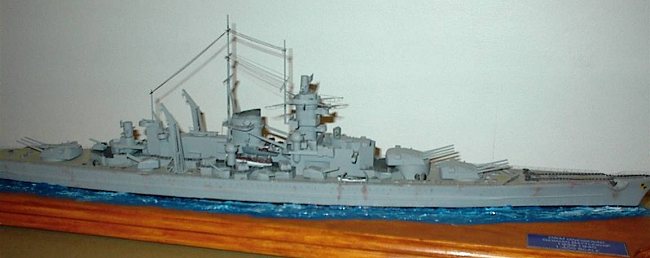
Copyright ModelingMadness.com
If you would like your product reviewed fairly and fairly quickly, please contact the editor or see other details in the Note to Contributors.